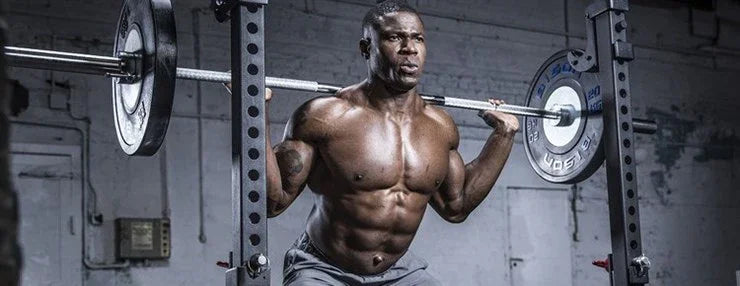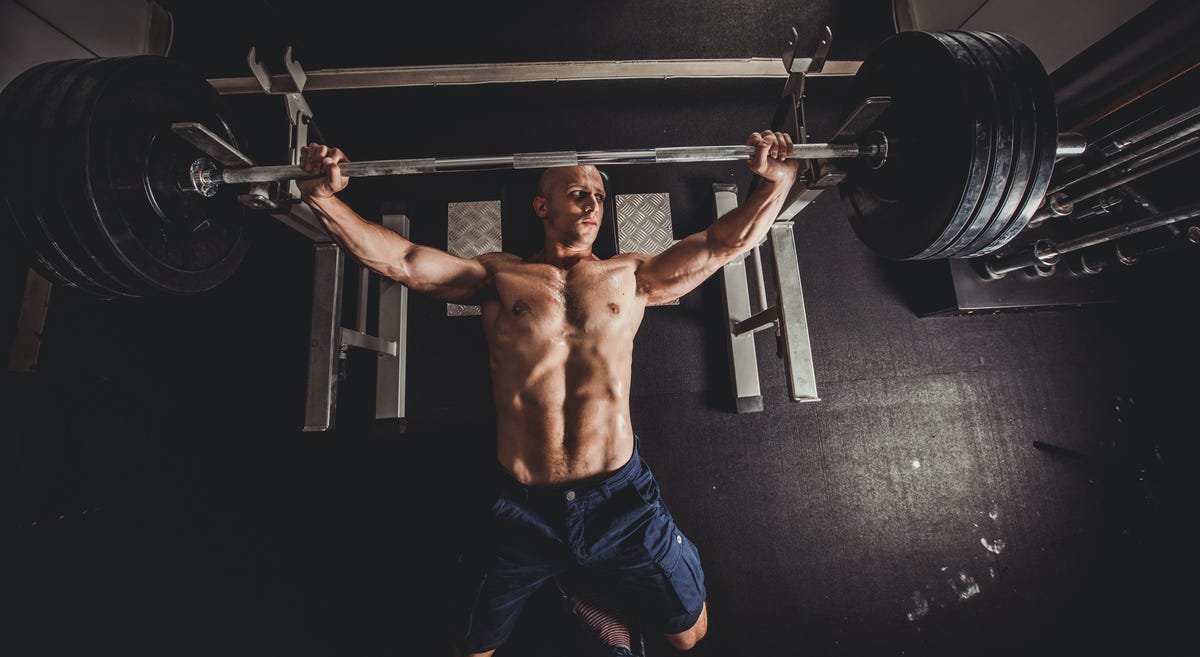Imagine transforming your body using just one piece of equipment. No fancy machines, no complex routines—just you and a barbell.
It sounds almost too simple, doesn’t it? But what if this simplicity holds the secret to unlocking your muscle-building potential? You might be surprised at what you can achieve with a barbell alone. This isn’t just another fitness fad; it’s a powerful tool that can redefine your strength and physique.
Are you curious about how you can maximize your workouts and achieve impressive results? Do you wonder if a single barbell can truly be your ultimate ally in building muscle? We’ll dive into the incredible potential of barbell exercises, and show you how this minimalist approach can lead to maximum gains. Prepare to challenge your understanding and discover a new path to strength. Let’s explore how a barbell can be the only thing standing between you and your fitness goals.

Benefits Of Barbell Training
Barbell training is a simple way to build strength and muscle. It uses one tool for many exercises. Many people wonder if a barbell alone can help them grow muscle.
This article explains the benefits of barbell training. It covers strength gains, muscle growth, and how it saves money.
Strength Gains With Barbells
Barbells allow you to lift heavy weights safely. They work multiple muscles at once. This builds total body strength fast.
Exercises like squats, deadlifts, and bench presses use barbells. These moves target many muscle groups. Using a barbell helps you get stronger every workout.
Muscle Growth Potential
Barbell training can grow muscle size effectively. You can increase weight in small steps. This gradual rise causes muscles to grow.
- Barbells let you do heavy compound lifts
- Compound lifts work many muscles at once
- Progressive overload is easy with barbells
- More muscle fibers get activated
- Improves muscle coordination and balance
Cost-effectiveness And Accessibility
| Aspect | Barbell Training |
| Equipment Cost | Low to Moderate |
| Space Needed | Small Area |
| Exercise Variety | Wide Range |
| Availability | Easy to Find |
| Long-Term Use | Durable and Lasting |
A barbell is a one-time buy. It works for many exercises. You do not need many machines or tools. This makes barbell training affordable and easy to start.
Key Barbell Exercises For Muscle Growth
Using a barbell can help you build strong muscles. It lets you lift heavy weights and work many muscle groups.
Here are some key barbell exercises to help you grow muscle efficiently.
Squats For Lower Body
Squats work your legs and hips. They target the quads, hamstrings, and glutes.
Squats help improve strength and muscle size in your lower body. They also build core stability.
- Place the barbell on your upper back.
- Stand with feet shoulder-width apart.
- Bend your knees and hips to lower down.
- Keep your back straight and chest up.
- Push through your heels to stand back up.
Deadlifts For Full Body
Deadlifts work many muscles at once. They mainly target your back, legs, and hips.
This exercise builds muscle and strength in your whole body. It also improves posture.
- Stand with feet hip-width apart.
- Grip the barbell with hands outside your legs.
- Keep your back flat and chest forward.
- Lift the barbell by pushing through your heels.
- Stand tall, then lower the bar back down.
Bench Press For Chest
The bench press targets your chest muscles. It also works your shoulders and triceps.
This exercise helps build upper body strength and size.
- Lie on a bench with feet flat on the floor.
- Grip the barbell slightly wider than shoulder-width.
- Lower the bar to your chest slowly.
- Push the bar up until arms are straight.
Overhead Press For Shoulders
The overhead press works your shoulder muscles. It also engages your triceps and upper chest.
This lift helps build strong and broad shoulders.
- Stand with feet shoulder-width apart.
- Hold the barbell at shoulder height.
- Press the bar straight overhead.
- Lower the bar back to shoulder level.
Barbell Rows For Back
Barbell rows target your upper and middle back. They also work your biceps and shoulders.
This exercise helps build a strong and thick back.
- Bend at the hips with a flat back.
- Hold the barbell with a grip wider than shoulders.
- Pull the bar toward your lower chest.
- Lower the bar slowly back down.
Designing A Barbell-only Workout
You can build muscle using only a barbell. A barbell allows many exercises for all muscle groups.
Designing a workout with just a barbell means choosing the right moves. This helps balance your strength training.
Balancing Push And Pull Movements
Push exercises work muscles that move weight away from your body. Pull exercises use muscles that pull weight toward you.
Balancing these movements helps prevent injury and builds even muscle strength.
- Push: Barbell bench press, overhead press
- Pull: Barbell rows, deadlifts
- Alternate push and pull on different workout days
Incorporating Compound Exercises
Compound exercises use many muscles at once. They save time and build more muscle.
Barbell compound moves engage your whole body and improve strength quickly.
- Squats work legs, hips, and core
- Deadlifts target back, glutes, and legs
- Bench press hits chest, shoulders, and triceps
- Overhead press strengthens shoulders and arms
Progressive Overload Strategies
Progressive overload means slowly increasing workout difficulty. This helps muscles grow stronger over time.
With a barbell, you can add weight, reps, or sets to challenge your muscles.
- Add small weight increments regularly
- Increase reps per set as strength improves
- Add more sets if you can maintain good form
- Track progress to adjust your workout plan

Nutrition’s Role In Muscle Building
Nutrition plays a big part in building muscle. Eating the right foods helps your body grow stronger.
Good nutrition works with exercise to build muscle effectively. It gives your body the fuel it needs.
Protein Requirements
Protein is the key nutrient for muscle repair and growth. Your muscles use protein to fix tiny tears from workouts.
You need enough protein daily to support muscle building. Aim for about 1.6 to 2.2 grams of protein per kilogram of body weight.
- Chicken, fish, and lean meats are good protein sources
- Plant proteins include beans, lentils, and tofu
- Protein shakes can help meet daily needs
Calorie Surplus Importance
Eating more calories than you burn helps you build muscle. This is called a calorie surplus.
A calorie surplus provides energy for muscle growth and recovery. Without it, your body may not build much muscle.
- Track your daily calorie intake
- Add 250 to 500 extra calories per day
- Choose healthy foods like nuts, whole grains, and fruits
Timing And Meal Frequency
Eating protein and calories at the right times helps muscle growth. Your body uses nutrients best when you spread meals through the day.
Try to eat every 3 to 4 hours. Include protein in each meal to support muscle repair.
- Have a protein-rich meal after your workout
- Include carbs to restore energy
- Stay hydrated to help muscle recovery
Common Challenges And Solutions
Building muscle with just a barbell can be tough. You might face some common problems along the way.
Knowing how to handle these issues helps you keep making progress safely and effectively.
Plateaus And How To Break Them
A plateau happens when your muscles stop growing or getting stronger. This can feel frustrating and slow your progress.
Changing your workout routine can help you break through plateaus and build muscle again.
- Increase the weight you lift gradually
- Change the number of sets and repetitions
- Try different barbell exercises to target muscles in new ways
- Take short breaks between sets to boost strength
- Focus on good form to get the most from each lift
Avoiding Overtraining
Overtraining happens if you exercise too much without enough rest. It can cause tired muscles and slow growth.
Balancing exercise with rest keeps your muscles healthy and growing stronger.
- Rest at least one day between heavy barbell workouts
- Listen to your body if you feel pain or extreme tiredness
- Get enough sleep to help muscle recovery
- Eat healthy foods to fuel your workouts and repair muscles
Injury Prevention Tips
Using a barbell can cause injuries if you do not use the right form or lift too much weight.
Following safety tips keeps you safe and helps your muscles grow without problems.
- Warm up your muscles before lifting
- Start with lighter weights and increase slowly
- Keep your back straight during lifts
- Use a spotter or safety bars when lifting heavy
- Stop if you feel sharp pain or discomfort

Tracking Progress With Barbells
Using a barbell for workouts can help build muscle effectively. To see real results, tracking your progress is important.
Tracking progress helps you know if your strength and muscle size are improving over time.
Measuring Strength Improvements
Strength gains are the main sign of muscle growth with barbells. Measure your lifting weight regularly.
Track how much weight you lift for sets and reps. Increasing weight or reps means you are getting stronger.
- Record the weight used for each exercise
- Note the number of sets and reps performed
- Compare data weekly or monthly
- Focus on gradual increases over time
Monitoring Muscle Size
Muscle size changes can show if your training is working. Use simple tools like measuring tape to check muscle growth.
Measure the same muscle groups regularly. Keep track of the numbers to see if your muscles are growing.
- Measure arms, chest, legs, or other target muscles
- Take measurements at the same time of day
- Use a flexible tape measure for accuracy
- Record measurements every 2-4 weeks
Using Training Logs Effectively
Training logs help you keep all your workout data in one place. Write down your exercises, weights, sets, and reps.
Review your logs to find patterns and adjust your workouts. Logs motivate you by showing progress over time.
- Record date and workout details every session
- Note how you feel during workouts
- Track rest periods and workout duration
- Use paper, apps, or spreadsheets for logging
Barbell Training Vs Other Equipment
Barbell training is a popular method for building muscle. It uses a single piece of equipment with weights on both ends. Other equipment like dumbbells, machines, and bodyweight exercises offer different benefits.
Comparing barbell training to these options helps you understand what each tool offers. This can guide you in planning your workouts.
Dumbbells And Machines Comparison
Dumbbells allow more movement freedom than barbells. They work each side of the body independently. Machines guide your motion and often isolate specific muscles.
| Equipment | Movement Type | Muscle Activation | Stability Needed |
| Barbell | Fixed path, both sides together | High | High |
| Dumbbells | Free movement, each side separate | Moderate to high | Moderate to high |
| Machines | Fixed path, guided | Low to moderate | Low |
Bodyweight Training Differences
Bodyweight training uses your own weight as resistance. It builds strength and muscle without any equipment. It trains balance, coordination, and endurance alongside muscle growth.
- Barbell training mainly adds heavy load.
- Bodyweight exercises focus on control and form.
- Bodyweight can be done anywhere, no gear needed.
- Barbells require space and weights.
Combining Barbell With Other Methods
Using barbells with dumbbells, machines, or bodyweight moves creates a balanced routine. This approach targets muscles in different ways and helps avoid plateaus.
- Start with barbell lifts for heavy strength work.
- Add dumbbells to improve muscle balance and range.
- Use machines to isolate muscles safely.
- Include bodyweight exercises for endurance and control.
- Mixing methods improves overall muscle growth.
Frequently Asked Questions
Can You Build Muscle Using Only A Barbell?
Yes, you can build muscle with just a barbell. It allows compound exercises targeting multiple muscle groups. Progressive overload with barbells efficiently promotes muscle growth. Proper form and consistent training are key to effective results.
What Barbell Exercises Best Build Muscle?
Squats, deadlifts, bench presses, overhead presses, and rows are top barbell exercises. These compound movements engage major muscles for strength and size. Incorporate variety and increase weights gradually for optimal muscle growth.
How Often Should You Train With A Barbell?
Training with a barbell 3-4 times per week is ideal. This frequency balances muscle recovery and growth. Avoid overtraining by allowing rest days and focusing on different muscle groups each session.
Can Beginners Build Muscle With Just A Barbell?
Absolutely. Beginners benefit from barbell training due to its simplicity and effectiveness. Starting with basic lifts helps build strength and form. Gradual progression prevents injury and encourages consistent muscle gains.
Conclusion
Building muscle with just a barbell is possible and effective. A barbell lets you do many strong exercises. You can work different muscles using simple moves. Consistency and good form matter the most. Eating well and resting help your progress too.
No need for fancy machines or many tools. Just a barbell and effort can bring great results. Keep your workouts steady and challenge yourself. Watch your strength and muscle grow over time. Yes, a barbell alone can build strong muscles.



